Donald Trump unveiled plans to step up his trade wars on Monday, announcing Japan and South Korea will soon face US tariffs of 25% in a significant escalation of his controversial economic strategy.
The US president, who indicated that he would notify as many as as 15 countries of new, higher rates on Monday, posted copies of letters addressed to the leaders of Japan and South Korea on social media. Trump said the rates were set to go into effect 1 August.
The letters were largely identical and informed the leaders that there will be no tariffs if their countries “decide to build or manufacture product within the United States”.
Trump also threatened higher tariffs if the countries place additional tariffs on US exports. “If for any reason you decide to raise your tariffs, then, whatever the number you choose to raise them by, will be added onto that 25% we charge,” he wrote.
Trump initially announced a slate of so-called reciprocal tariffs in April, on what the White House dubbed “liberation day”, with some countries facing rates as high as 50%
While he paused those tariffs for 90 days amid market turmoil, this reprieve is due to expire on Wednesday 9 July.
Trump officials initially suggested they would strike dozens of deals with key economies during the pause, but have since indicated that they would use an extension to continue talks.
The treasury secretary, Scott Bessent, said last month the administration was aiming to wrap up negotiations by Labor Day on 1 September.
The US has so far settled deals with three countries: the UK, China and Vietnam, and Bessent said there were over a dozen countries the US is still trying to negotiate with.
The new August deadline for countries without a deal amounts to a further three-week reprieve, but also triggers fresh uncertainty for importers because of the lack of clarity around the tariffs.
As the July deadline has approached, Trump’s officials have been racing to broker deals. Over the weekend, one European diplomat said the US may have to “show muscle if the deal is not good enough”.
The White House also reached an impasse in negotiations with Japan, despite initial optimism. Trump on Friday said it is “much easier to send a letter” and that the offers are “take it or leave it”.
On Wall Street, the benchmark S&P 500 sank by almost 0.9% after Trump posted his first letters.
Though the US stock market has largely recovered from the uncertainty around Trump’s trade war, the US dollar still remains weakened after months of trade fights. At the beginning of this year, the dollar had its worst six months in over 50 years, falling 10.8% since the start of 2025.
